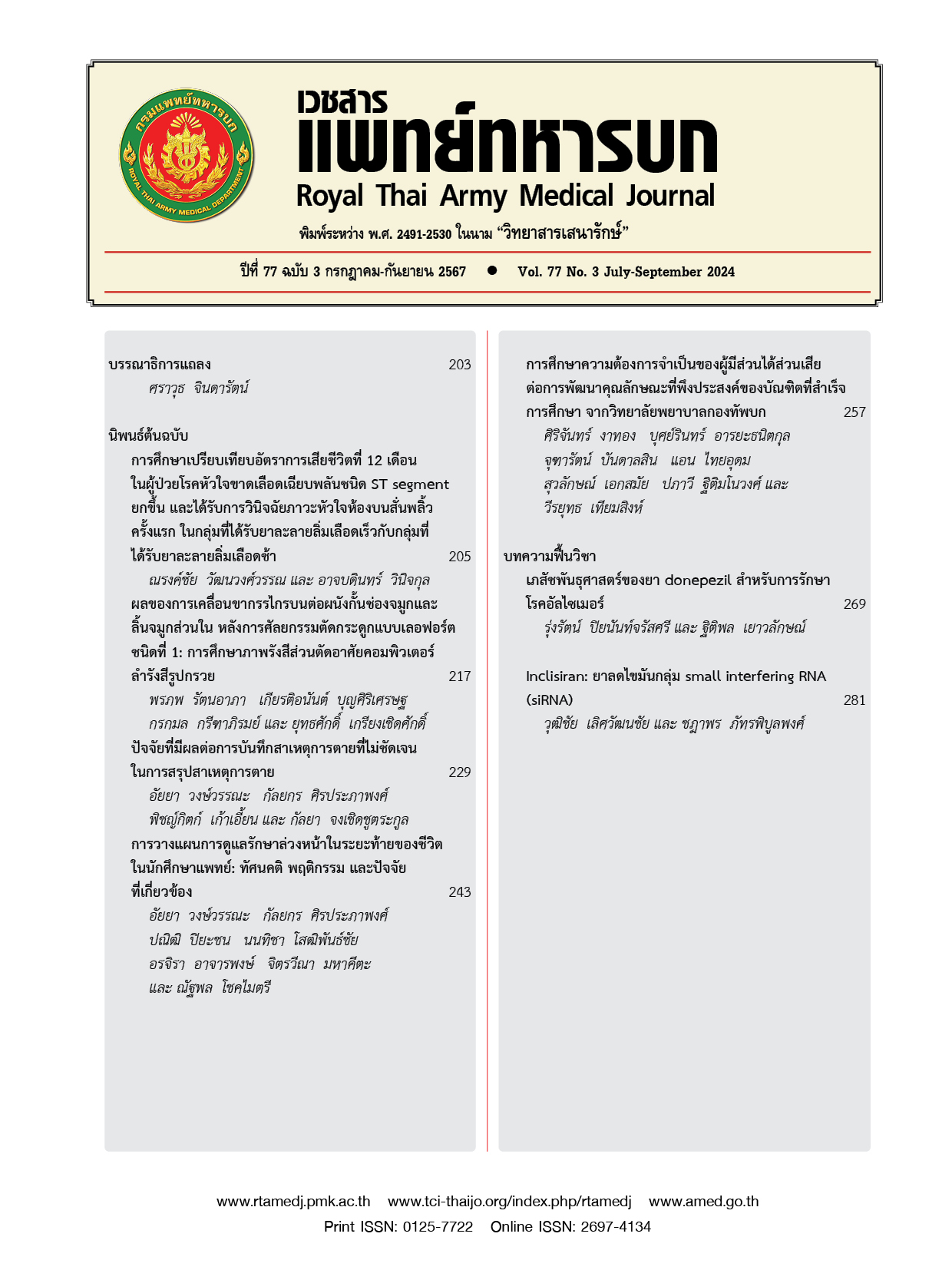ผลของการเคลื่อนขากรรไกรบนต่อผนังกั้นช่องจมูกและลิ้นจมูกส่วนใน หลังการศัลยกรรมตัดกระดูกแบบเลอฟอร์ตชนิดที่ 1: การศึกษาภาพรังสีส่วนตัดอาศัยคอมพิวเตอร์ลำรังสีรูปกรวย
Main Article Content
บทคัดย่อ
วัตถุประสงค์ การศัลยกรรมตัดกระดูกแบบเลอฟอร์ตชนิดที่ 1 เป็นเทคนิคการผ่าแก้ไขเคลื่อนที่กระดูกขากรรไกรบนทั้งชิ้นและรวมถึงฟันบนให้มาอยู่ในตำแหน่งที่เหมาะสม การวิจัยนี้มีวัตถุประสงค์เพื่อประเมินผลของการเคลื่อนขากรรไกรบนต่อผนังกั้นช่องจมูกและลิ้นจมูกส่วนในภายหลังการศัลยกรรมตัดกระดูกแบบเลอฟอร์ตชนิดที่ 1 วิธีการวิจัย การศึกษาย้อนหลังภาพรังสีส่วนตัดอาศัยคอมพิวเตอร์ลำรังสีรูปกรวยของ ผู้ป่วยจำนวน 39 คน ที่ได้รับการรักษาโดยการศัลยกรรมตัดกระดูกแบบเลอฟอร์ตชนิดที่ 1 โดยแบ่งผู้ป่วยออกเป็นสามกลุ่มตามการเคลื่อนที่ของขากรรไกรบน กลุ่มที่ 1 เคลื่อนกระดูกขากรรไกรบนมาทางด้านหน้า กลุ่มที่ 2 เคลื่อนกระดูกขากรรไกรบนไปทางด้านบน กลุ่มที่ 3 เคลื่อนกระดูกขากรรไกรบนมาทางด้านหน้าและไปทางด้านบน โดยมุมผนังกั้นช่องจมูก มุมลิ้นจมูกส่วนใน และพื้นที่ลิ้นจมูกส่วนในจะถูกวัดก่อนและหลังรักษาและนำมาวิเคราะห์ ผลการศึกษา หลังการทำศัลยกรรม ค่ามัธยฐานของมุมผนังกั้นช่องจมูกและค่าเฉลี่ยของมุมลิ้นจมูกส่วนในของค่าเพิ่มขึ้นอย่างมีนัยสำคัญทางสถิติ เมื่อเปรียบเทียบระหว่างทั้งสามกลุ่มแล้วพบว่าแตกต่างกันอย่างไม่มีนัยสำคัญทางทางสถิติ ความสัมพันธ์ระหว่างการเปลี่ยนแปลงของมุมผนังกั้นช่องจมูกและระยะทางการเคลื่อนที่กระดูกขากรรไกรบนมาทางด้านหน้าพบว่ามีความสัมพันธ์เชิงบวก ระดับปานกลางและมีนัยสำคัญทางทางสถิติ สรุป การเคลื่อนกระดูกขากรรไกรบนมาทางด้านหน้าและ/หรือไปทางด้านบนในงานศัลยกรรมตัดกระดูกแบบเลอฟอร์ตชนิดที่ 1 ส่งผลต่อการเพิ่มขึ้นของมุมผนังกั้นช่องจมูกและมุมลิ้นจมูกส่วนใน และพบความสำพันธ์เชิงบวกระดับปานกลางระหว่างการเปลี่ยนแปลงของมุมผนังกั้นช่องจมูกและระยะทางการเคลื่อนที่กระดูกขากรรไกรบนมาทางด้านหน้า
Downloads
Article Details

อนุญาตภายใต้เงื่อนไข Creative Commons Attribution-NonCommercial-NoDerivatives 4.0 International License.
บทความในวารสารนี้อยู่ภายใต้ลิขสิทธิ์ของ กรมแพทย์ทหารบก และเผยแพร่ภายใต้สัญญาอนุญาต Creative Commons Attribution-NonCommercial-NoDerivatives 4.0 International (CC BY-NC-ND 4.0)
ท่านสามารถอ่านและใช้งานเพื่อวัตถุประสงค์ทางการศึกษา และทางวิชาการ เช่น การสอน การวิจัย หรือการอ้างอิง โดยต้องให้เครดิตอย่างเหมาะสมแก่ผู้เขียนและวารสาร
ห้ามใช้หรือแก้ไขบทความโดยไม่ได้รับอนุญาต
ข้อความที่ปรากฏในบทความเป็นความคิดเห็นของผู้เขียนเท่านั้น
ผู้เขียนเป็นผู้รับผิดชอบต่อเนื้อหาและความถูกต้องของบทความของตนอย่างเต็มที่
การนำบทความไปเผยแพร่ซ้ำในรูปแบบสาธารณะอื่นใด ต้องได้รับอนุญาตจากวารสาร
เอกสารอ้างอิง
Kramer FJ, Baethge C, Swennen G, Teltzrow T, Schulze A, Berten J, et al. Intra- and perioperative complications of the Le Fort I osteotomy: A prospective evaluation of 1,000 patients. J Craniofac Surg. 2004;15(6):971-7.
Eliason MJ, Schafer J, Archer B, Capra G. The Impact on Nasal Septal Anatomy and Physiology Following Le Fort I Osteotomy for Orthognathic Surgery. J Craniofac Surg. 2021;32(1):277-81.
Hilberg O. Objective measurement of nasal airway dimensions using acoustic rhinometry: methodological and clinical aspects. Allergy. 2002;57(70):5-39.
Rattana-arpha P, Boonsiriseth K, Kretapirom K, Kriangcherdsak Y. Assessment of Nasal Septum Change after Le Fort I Osteotomy Using Cone Beam Computed Tomography. J Maxillofac Oral Surg. 2023;22(4):799-805.
Suh MW, Jin HR, Kim JH. Computed tomography versus nasal endoscopy for the measurement of the internal nasal valve angle in Asians. Acta Otolaryngol. 2008;128(6):675-9.
Harris D, Horner K, Gröndahl K, Jacobs R, Helmrot E, Benic GI, et al. EAO guidelines for the use of diagnostic imaging in implant dentistry 2011. A consensus workshop organized by the European Association for Osseointegration at the Medical University of Warsaw. Clin Oral Implants Res. 2012;23(11):1243-53.
Bloom JD, Sridharan S, Hagiwara M, Babb JS, White WM, Constantinides M. Reformatted computed tomography to assess the internal nasal valve and association with physical examination. Arch Facial Plast Surg. 2012;14:331-5.
Poetker DM, Rhee JS, Mocan BO, Michel MA. Computed tomography technique for evaluation of the nasal valve. Arch Facial Plast Surg. 2004;6:240-3.
Schober P, Boer C, Schwarte LA. Correlation coefficients: appropriate use and interpretation. Anesth Analg. 2018;126(5): 1763-8.
On SW, Baek SH, Choi JY. Quantitative Evaluation of the Postoperative Changes in Nasal Septal Deviation by Diverse Movement of the Maxilla After Le Fort I Osteotomy. J Craniofac Surg. 2020;31(5):1251-5.
Posnick JC, Fantuzzo JJ, Troost T. Simultaneous intranasal procedures to improve chronic obstructive nasal breathing in patients undergoing maxillary (le fort I) osteotomy. J Oral Maxillofac Surg. 2007;65(11):2273-81.
Shin YM, Lee ST, Kwon TG. Surgical correction of septal deviation after Le Fort I osteotomy. Maxillofac Plast Reconstr Surg. 2016;38(1):21
Verse T, Pirsig W. Impact of impaired nasal breathing on sleepdisordered breathing. Sleep Breath. 2003;7:63-6.
Lepley TJ, Frusciante RP, Malik J, Farag A, Otto BA, Zhao K. Otolaryngologists’ radiological assessment of nasal septum deviation symptomatology. Eur Arch Otorhinolaryngol. 2023;280(1):235-40.
Aziz T, Biron VL, Ansari K, Flores-Mir C. Measurement tools for the diagnosis of nasal septal deviation: a systematic review. J Otolaryngol Head Neck Surg. 2014;43(1):11.
Mamikoglu B, Houser S, Akbar I, Ng B, Corey JP. Acoustic rhinometry and computed tomography scans for the diagnosis of nasal septal deviation, with clinical correlation. Otolaryngol Head Neck Surg. 2000;123(1):61-8.
Chandra RK, Patadia MO, Raviv J. Diagnosis of nasal airway obstruction. Otolaryngol Clin North Am. 2009;42(2):207-25.
Aung SC, Foo CL, Lee ST. Three dimensional laser scan assessment of the oriental nose with a new classification of Oriental nasal types. Br J Plast Surg. 2000;53(2):109-16.
Shia Ng L, Lo S. Management of the internal nasal valve. Int J Otorhinolaryngol Clin. 2013;5(1):43-5.
Egan KK, Kezirian EJ, Kim DW. Nasal obstruction and sleep-disordered breathing. Oper Tech Otolaryngol. 2006;17:268-72.
Moche JA, Cohen JC, Pearlman SJ. Axial computed tomography evaluation of the internal nasal valve correlates with clinical valve narrowing and patient complaint. Int Forum Allergy Rhinol. 2013;3(7):592-7.
Mladina R, Cujić E, Subarić M, Vuković K. Nasal septal deformities in ear, nose, and throat patients: an international study. Am J Otolaryngol. 2008;29(2):75-82.
Dilaver E, Ak KB, Süzen M, Altın G, Uçkan, S. Evaluation of internal nasal valve using computed tomography after Le Fort I osteotomy: A cross-sectional study from a tertiary center. Med Bull Haseki. 2021;59(5):400-4.
Yoon A, Abdelwahab M, Liu S, Oh J, Suh H, Trieu M, et al. Impact of rapid palatal expansion on the internal nasal valve and obstructive nasal symptoms in children. Sleep Breath. 2021;25(2):1019-27.
Baeg SW, Hong YP, Cho DH, Lee JK, Song SI. Evaluation of Sinonasal Change After Lefort I Osteotomy Using Cone Beam Computed Tomography Images. J Craniofac Surg. 2018;29(1):e34-e41.
Atakan A, Ozcirpici AA, Pamukcu H, Bayram B. Does Le Fort I osteotomy have an influence on nasal cavity and septum deviation? Niger J Clin Pract. 2020;23(2):240-5.
Nocini PF, D’Agostino A, Trevisiol L, Favero V, Pessina M, Procacci P. Is Le Fort I Osteotomy Associated With Maxillary Sinusitis? J Oral Maxillofac Surg. 2016;74(2):400.e1-400.e12.
Valstar MH, Baas EM, Te Rijdt JP, De Bondt BJ, Laurens E, De Lange J. Maxillary sinus recovery and nasal ventilation after Le Fort I osteotomy: a prospective clinical, endoscopic, functional and radiographic evaluation. Int J Oral Maxillofac Surg. 2013;42(11):1431-6.
Erbe M, Lehotay M, Gode U, Wigand ME, Neukam FW. Nasal airway changes after Le Fort I— Impaction and advancement: anatomical and functional findings. Int J Oral Maxillofac Surg. 2001;30(2):123-9.
Honrado CP, Lee S, Bloomquist DS, Larrabee WF, Jr. Quantitative assessment of nasal changes after maxillomandibular surgery using a 3-dimensional digital imaging system. Arch Facial Plast Surg. 2006;8(1):26-35.
Ghoreishian M, Gheisari R. The effect of maxillary multidirectional movement on nasal respiration. J Oral Maxillofac Surg. 2009;67(10):2283-6.
Haarmann S, Budihardja AS, Wolff KD, Wangerin K. Changes in acoustic airway profiles and nasal airway resistance after Le Fort I osteotomy and functional rhinosurgery: a prospective study. Int J Oral Maxillofac Surg. 2009;38(4):321-5.
Pourdanesh F, Sharifi R, Mohebbi A, Jamilian A. Effects of maxillary advancement and impaction on nasal airway function. Int J Oral Maxillofac Surg. 2012;41(11):1350-2.
Howley C, Ali N, Lee R, Cox S. Use of the alar base cinch suture in Le Fort I osteotomy: is it effective? Br J Oral Maxillofac Surg. 2011;49(2):127-30.


